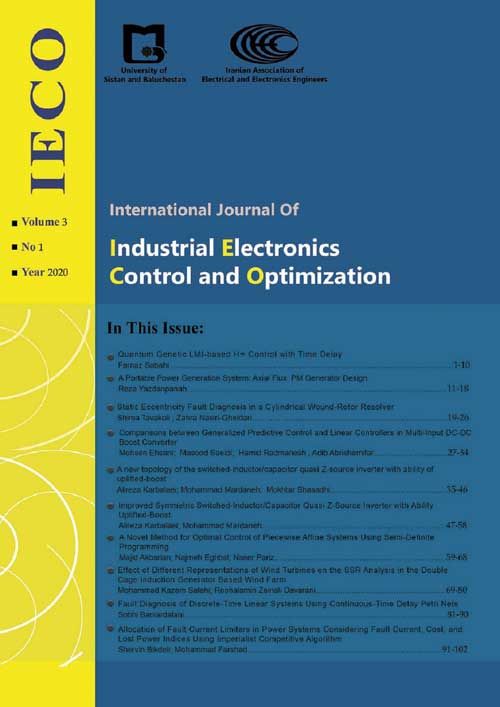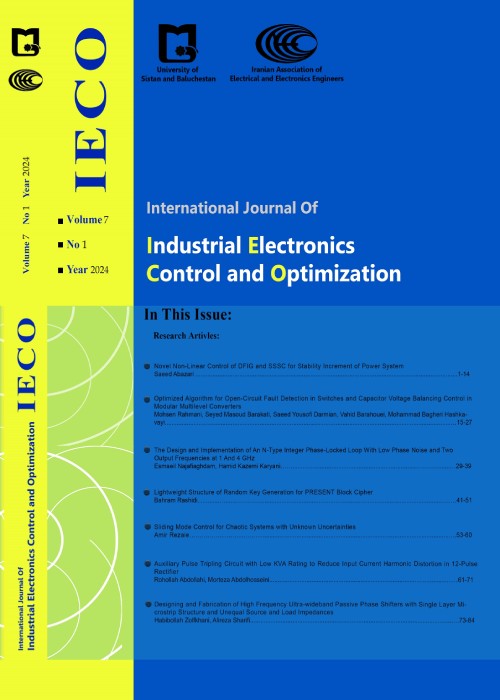فهرست مطالب

International Journal of Industrial Electronics, Control and Optimization
Volume:3 Issue: 1, Winter 2020
- تاریخ انتشار: 1398/10/11
- تعداد عناوین: 10
-
-
Pages 1-10
One of the main problems underlying most optimization theories is local optimum. When time delays are presented, this issue becomes much more problematic. In such conditions, evolutionary optimization algorithms are proven to be helpful. In this paper, quantum genetic algorithm (QGA) has been used to tackle the stated problem in the framework of delay-dependent linear matrix inequality (LMI) robust H∞ control. QGA is employed to find suitable feedback gains and delay-dependent LMI solvers are concerned to resolve stability issues. In addition, to provide more balance between exploration and exploitation, to increase convergence rate as well as to prevent premature convergence, it is proposed that particle swarm optimization (PSO) is augmented with QGA. Simulation is dealt with LMI-based H∞ control scheme of the QGA and QGA-PSO optimization space from the design point of one-degree freedom single link scara robot. The whole controller satisfies the desired properties for uncertain-but-known constant bounded time delay. Furthermore, one of the drawbacks found in tests of most hybrid global-local strategies, i.e. premature convergence, has been cancelled by the proposed scheme of QGA and PSO.
Keywords: H∞ control, Linear matrix inequality (LMI), Quantum genetic algorithm (QGA), Time Delay -
Pages 11-18Design methodology of the compact size charging system for emergency uses is investigated in this paper. The system consists of a gearing unit, generator, charger and battery cells. The system electrical model has been introduced and a 3-phase axial flux surface mounted PM generator with concentrated winding is picked as a generation unit. The basic equations needed for the generator design are presented as well as general considerations and constraints for the designs. After validating the design equations using Finite Element Analysis, sizing equations are used to design different machines. The resulted designs are compared based on main characteristics including output power, delivered power to the battery, and generator efficiency. Finally, the performances of valid designs in the system model are analyzed on the wide speed range. The proposed methodology could be used for portable power generation units design for applications such as rescuing, power system outage, camping, so on.Keywords: Axial flux, Design, Optimization, Permanent Magnet Synchronous Generator, Portable Power Generation
-
Pages 19-26
Static eccentricity (SE) is an intrinsic fault existing in both faulty and newly made resolvers. The late diagnosis of SE causes severe damages to mechanical parts of resolver such as bearings, cores and even windings, in addition to wrong position estimation. However, so far fault diagnosis has not been investigated for any Resolver. In this paper, SE fault diagnosis is discussed for a sample wound-rotor (WR) cylindrical resolver. Time stepping finite element method (TSFEM) is used to simulate the resolver, and its accuracy is validated by a comparison between the results of simulation and experimental tests. Then, some fault indices are defined to diagnose the SE fault occurrence, and its magnitude is predicted using Fast Fourier transform (FFT). Finally, to ensure that indices are unique, the performance of the studied resolver is evaluated under other types of faults including Dynamic Eccentricity (DE) and Short-circuit (SC) that may excite the same indices.
Keywords: Wound Rotor Resolver, Fault Diagnosis, Finite Element Analysis -
Pages 27-34In this paper, the linear state-space model of the multi-input DC-DC boost converter is obtained and based on, a linear SISO model is calculated. Model predictive control (MPC) offers a novel method of designing in the power electronic converters. The application to DC-DC converters offers real benefits because of having simple tuning technique and analytical guaranteed stability. The weakness of this converter is non minimum phase behavior. One of the methods of implementation MPC controller is Generalized Predictive Control (GPC) which is compatible with non-minimum phase systems but due to simple implementation, using of the linear controller is more popular in power electronics control system. GPC has some advantage such as fast dynamic and robustness in the nonlinear system however main advantage of linear controllers is its low steady state error. The main idea of this paper is the investigation performance of GPC and linear controller in the multi-input DC-DC boost converter and camper with PI controller in term of dynamic, steady-state error, and robustness and run time in a microcontroller. The resulting of this comparison is critically assessed in simulation and algorithms ruining time has been compared in microcontroller hardware.Keywords: MPC, boost converter, linear controller, runtime
-
Pages 35-46In this paper, a new topology of switched-inductor/capacitor quasi impedance source inverter is suggested, which in comparison with the other topologies possesses higher boost voltage inversion at high modulation index and low shoot through duty cycle. Also, this topology has features like continuous input current, common ground between the input source and the inverter bridge and, low shoot-through current. To express the proposed topology properties, it is compared experimentally in similar conditions relative to the Enhances Boost quasi Z-Source inverter (EB-qZSI). Similar to the EB-QZSI, because of the presence of a series inductor with input voltage source, the inrush current at start-up is limited in the proposed topology. Also, the low voltage stress on the capacitors and the low current ripple of the inductors and the input source are other advantages. Due to the lower number of diodes in the proposed inverter, the efficiency is higher compared to the EB-qZSI inverter. The performance of the proposed topology is confirmed with MATLAB/SIMULINK software. The results of simulation and experimental validate the theoretical analysis of the proposed topology. The experimental results validate the simulation results and there is a good agreement between the simulation results and the experimental results.Keywords: quasi Z-source inverter (qZSI), Boost factor, voltage stress, current ripple
-
Pages 47-58This paper proposes a topology of switched-inductor/capacitor quasi z-source inverter (SIC-qZSI), which based on the classic qZSI. This topology is symmetric and has a high boost factor in the low duty cycle and high modulation index. Also, the low voltage stress on the capacitors and the low current ripple of the inductors and the input source are other advantages. In addition, the current of all inductors and the input current are equal, and the voltage across all the inductors, as well as the voltage across all diodes, are equal. This inverter has continuous current in the input source, and has common ground between the input voltage source and the inverter bridge. In order to express the features of the proposed inverter, it is compared experimentally in similar conditions relative to the Enhances Boost quasi Z-Source inverter (EB-qZSI). The performance of the proposed topology is confirmed with MATLAB/SIMULINK software and the simulation results and obtained relations are accredit by using a prototype of the proposed inverter.Keywords: Boost factor, impedance network, quasi Z-source inverter (q-ZSI), voltage stress
-
Pages 59-68
In this paper, a novel optimal control design method by discontinuous quadratic Lyapunov function and continuous quadratic Lyapunov function for 2-dimensional piecewise affine systems via semi-definite programming and LMI constraints is proposed.In fact, for designing optimal control we use from two different criteria. At the first, an upper bound for a quadratic cost function for a stable closed-system is obtained. Then after, considering a state-feedback control approach, not only sufficient conditions for the stability of the closed-loop system but also the upper bound of the cost function are obtained. The optimization problem is formulated as a semi-definite programming with bilinear constraints (BMI). Some variables in BMIs are searched by genetic algorithm, so the bilinear constraints are converted to linear constraints and the controller coefficients are calculated. The effectiveness of the proposed method is verified by numerical examples. The simulation results show that discontinuous quadratic lyapunov functions are more efficient that continuous quadratic lyapunov functions.
Keywords: Piecewise affine systems, state-feedback, discontinues quadratic Lyapunov function, continuous quadratic Lyapunov functions -
Pages 69-80In this paper different representations of a wind farm based on double-cage induction generators connected to a series-compensated line is studied and their effect on the Subsynchronous Resonance (SSR) is analyzed. For this purpose, three representation types of wind turbines in SSR studies of the wind farm are considered as 1) Single Turbine Representation (STR), 2) Multiple Turbine Representation (MTR), and 3) Full Turbine Representation (FTR). To select the acceptable representation of the wind farm in SSR analysis, the wind farm is modeled by three representation and the test system eigenvalues are obtained for different conditions of the power system and the results are compared together. For this purpose, three scenarios are considered. In the first and second scenarios, all of the Wind Turbine Generators (WTGs) have identical electrical and mechanical parameters but WTGs in the third scenario are different. In the first scenario, all wind turbines are subjected to the same wind speed, and in the second and third scenarios, each group of wind turbines is subjected to the same wind speed. In addition, the analytical results are validated by electromagnetic transient simulation using PSCAD/EMTDC software.Keywords: Wind power plant, Wind Turbine Representation, Double Cage Induction Generator, Sub-synchronous Resonance, Wind Turbines Modeling
-
Pages 81-90This paper deals with fault diagnosis of a linear continuous variable dynamical system represented by a discrete state space model. The proposed fault diagnoser is based on a special Petri Net called Continuous Time Delay Petri Net (CTDPN). Thanks to the theorem presented in this paper, an exact correspondence between discrete-state space equations and fundamental equations of the CTDPN can be established. Based on this theorem, a systematic method is presented for realization of classical parity equations by a CTDPN that plays the role of the fault diagnoser. By integrating the concept of state space models and Petri Nets in this paper, new and effective methods can be proposed for analyzing and fault diagnosis of hybrid systems. Finally, the performance of the proposed method is investigated for fault diagnosis of a DC motor. The results show that with the help of proposed Petri net, fault diagnosis can be done well and traditional diagnoser can be replaced with this network.Keywords: continuous-Time Delay Petri Net, Fault Diagnosis, Parity Equations, State-Space Model
-
Pages 91-102Developments in power systems like the installation of new generation resources and interconnections may increase short-circuit current levels and consequently, impose additional costs of replacing circuit breakers and equipment. In these cases, one of the best methods to reduce short-circuit currents in power systems and avoid significant replacement costs is to use fault current limiters (FCLs). This paper suggests a new method for optimally locating and sizing FCLs using an imperialist competitive algorithm (ICA). The ICA finds the optimal locations and sizes of FCLs such that not only are short-circuit currents reduced, but the size of the installed FCLs is also minimized, and the system reliability is increased. Indeed, three indices including the short-circuit level, the economic cost of FCLs, and the lost power are integrated into an objective function with a new formulation. The results obtained from multiple executions of the suggested procedure for the 39-bus New England benchmark system confirm that the formulation of indices in the objective function is suitable and the indices can be prioritized easily. Also, the results indicate that the ICA can find the optimal locations and sizes of FCLs with good convergence and accuracy considering the specified objectives and priorities.Keywords: power system, imperialist competitive algorithm, fault current limiter, reliability


